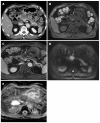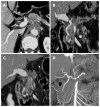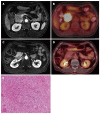Imaging diagnosis of pancreatic cancer: a state-of-the-art review
- PMID: 24976723
- PMCID: PMC4069314
- DOI: 10.3748/wjg.v20.i24.7864
Imaging diagnosis of pancreatic cancer: a state-of-the-art review
Abstract
Pancreatic cancer (PC) remains one of the deadliest cancers worldwide, and has a poor, five-year survival rate of 5%. Although complete surgical resection is the only curative therapy for pancreatic cancer, less than 20% of newly-diagnosed patients undergo surgical resection with a curative intent. Due to the lack of early symptoms and the tendency of pancreatic adenocarcinoma to invade adjacent structures or to metastasize at an early stage, many patients with pancreatic cancer already have advanced disease at the time of their diagnosis and, therefore, there is a high mortality rate. To improve the patient survival rate, early detection of PC is critical. The diagnosis of PC relies on computed tomography (CT) and/or magnetic resonance imaging (MRI) with magnetic resonance cholangiopancreatography (MRCP), or biopsy or fine-needle aspiration using endoscopic ultrasound (EUS). Although multi-detector row computed tomography currently has a major role in the evaluation of PC, MRI with MRCP facilitates better detection of tumors at an early stage by allowing a comprehensive analysis of the morphological changes of the pancreas parenchyma and pancreatic duct. The diagnosis could be improved using positron emission tomography techniques in special conditions in which CT and EUS are not completely diagnostic. It is essential for clinicians to understand the advantages and disadvantages of the various pancreatic imaging modalities in order to be able to make optimal treatment and management decisions. Our study investigates the current role and innovative techniques of pancreatic imaging focused on the detection of pancreatic cancer.
Keywords: Endoscopic ultrasound-guided fine needle aspiration; Magnetic resonance imaging; Multi-detector computed tomography; Pancreatic neoplasms; Positron-emission tomography; Ultrasonography.
Figures





Similar articles
-
Applications of endoscopic ultrasound in pancreatic cancer.World J Gastroenterol. 2014 Jun 28;20(24):7808-18. doi: 10.3748/wjg.v20.i24.7808. World J Gastroenterol. 2014. PMID: 24976719 Free PMC article. Review.
-
Role of (18)F-fluorodeoxyglucose positron emission tomography/computed tomography in diagnosis and management of pancreatic cancer; comparison with multidetector row computed tomography, magnetic resonance imaging and endoscopic ultrasonography.Rev Esp Med Nucl Imagen Mol. 2014 May-Jun;33(3):159-64. doi: 10.1016/j.remn.2013.08.005. Epub 2013 Oct 17. Rev Esp Med Nucl Imagen Mol. 2014. PMID: 24140024
-
Pancreatic cancer: current concepts in imaging for diagnosis and staging.Cancer J. 2001 Jul-Aug;7(4):298-311. Cancer J. 2001. PMID: 11561606 Review.
-
Multimodality imaging of pancreatic ductal adenocarcinoma: a review of the literature.HPB (Oxford). 2012 Oct;14(10):658-68. doi: 10.1111/j.1477-2574.2012.00508.x. Epub 2012 Jun 14. HPB (Oxford). 2012. PMID: 22954001 Free PMC article. Review.
-
[The role of multi-detector-row computed tomograph in the diagnosis of intraductal papillary-mucinous tumors of the pancreas in comparison to endoscopic retrograde pancreatography, endoscopic ultrasonography, magnetic resonance cholangiopancreatography].Nihon Shokakibyo Gakkai Zasshi. 2007 Mar;104(3):373-80. Nihon Shokakibyo Gakkai Zasshi. 2007. PMID: 17337874 Japanese.
Cited by
-
Serum levels of IL-6, IL-8, and IL-10 are indicators of prognosis in pancreatic cancer.J Int Med Res. 2018 Dec;46(12):5228-5236. doi: 10.1177/0300060518800588. Epub 2018 Oct 10. J Int Med Res. 2018. PMID: 30304975 Free PMC article.
-
The Urokinase Plasminogen Activation System in Pancreatic Cancer: Prospective Diagnostic and Therapeutic Targets.Biomolecules. 2022 Jan 18;12(2):152. doi: 10.3390/biom12020152. Biomolecules. 2022. PMID: 35204653 Free PMC article. Review.
-
MALDI Mass Spectrometry Imaging for the Distinction of Adenocarcinomas of the Pancreas and Biliary Tree.Molecules. 2022 May 27;27(11):3464. doi: 10.3390/molecules27113464. Molecules. 2022. PMID: 35684402 Free PMC article.
-
A Review of Pancreatic Cancer: Epidemiology, Genetics, Screening, and Management.Open Access Maced J Med Sci. 2019 Feb 14;7(4):663-671. doi: 10.3889/oamjms.2019.104. eCollection 2019 Feb 28. Open Access Maced J Med Sci. 2019. PMID: 30894932 Free PMC article. Review.
-
Incremental Role of Pancreatic Magnetic Resonance Imaging after Staging Computed Tomography to Evaluate Patients with Pancreatic Ductal Adenocarcinoma.Cancer Res Treat. 2019 Jan;51(1):24-33. doi: 10.4143/crt.2017.404. Epub 2018 Feb 5. Cancer Res Treat. 2019. PMID: 29397657 Free PMC article.
References
-
- Hidalgo M. Pancreatic cancer. N Engl J Med. 2010;362:1605–1617. - PubMed
-
- Siegel R, Naishadham D, Jemal A. Cancer statistics, 2013. CA Cancer J Clin. 2013;63:11–30. - PubMed
-
- Li D, Xie K, Wolff R, Abbruzzese JL. Pancreatic cancer. Lancet. 2004;363:1049–1057. - PubMed
-
- Jemal A, Siegel R, Ward E, Hao Y, Xu J, Murray T, Thun MJ. Cancer statistics, 2008. CA Cancer J Clin. 2008;58:71–96. - PubMed
Publication types
MeSH terms
LinkOut - more resources
Full Text Sources
Other Literature Sources
Medical

